The relationship between stocks and bonds was turned on its head in 2022. Will we see a return to normalcy in 2023? What factors should be considered when evaluating fixed income vs. equity holdings?
Join Blue Chip Partners’ Director of Investments Daniel Dusina, Managing Partner Dan Seder, and Senior Financial Advisor Matt Mondoux for a look at some topics to keep an eye on as 2023 gets underway. Watch the webinar replay of our Q1 2023 Quarterly Edge Live below!
Originally Recorded:
January 18, 2023 at 4:00 P.M. E.T.
Transcript:
[00:00:00] Daniel Dusina: Well, thanks again everyone for joining. We have some great content for you today. I’m Daniel Dusina, Director of Investments here at Blue Chip Partners, for those who I have not spoken with in the past. I’m joined today by Dan Seder, Managing Director and Matt Mondoux, Senior Financial Advisor. We all know what happened in the equity and fixed income markets in 2022, and so instead of trying to decipher and explain all the minutia of rationale why performance was negative, we want to explain some of our thoughts on a go-forward basis.
And I think this will be especially powerful because we will engage in a round table format in which myself and Dan and Matt will pose some questions to each other. And by the way, you all should feel free to chime in with questions as well using the functionality through the Go-To Meeting app or however you’re joining.
I will note before we kick things off here, that if you do want to get this type of content a little bit sooner than waiting for these live webinars, you should follow us, subscribe to us on LinkedIn, and keep up with our blog on bluechippartners.com. From outlook perspective, as we look at calendar year 2023, there really are two primary arguments that I hear from the retail investor base as it pertains to markets.
Number one, it’s that since interest rates are still slated to rise here in the US and bond prices and yields move in opposite directions, fixed income is broadly unattractive at this juncture. Number two, since we may be heading into a recession, there will be immense press on earnings and thus equities are also un-investible.
We think these two arguments are a bit too generalized, and just as we’ve done in past quarters, we set out three key themes in our quarterly outlook, and I think that this quarter for you all, the themes are designed to counteract and provide a little bit more insight into unpacking these generalized arguments.
So more specifically, Matt will kick things off by talking about our first team. It relates to asset allocation. He’s going to talk about the relative attractiveness of stocks and bonds. Second, Matt will turn it over to Dan and myself. We’ll talk a little bit more intricately about fixed income markets. Where are we a bit more cautious? Where are we seeing opportunities, and what does this mean for us as investors going forward? And finally, Dan and Matt will discuss some of the equity equation. Yes, we do believe that there is likely going to be some earnings pressure. We think corporate earnings estimates across Wall Street are too high right now, but we will show that that doesn’t necessarily mean that it has to equate to a negative outcome for equity markets through the calendar year.
So without further ado, Matt, my first question to you is: with regards to stocks and bonds, do you have any particular observations as we enter a new calendar?
[00:03:05] Matt Mondoux: Yeah, so the bond holder looking to finally earn an interest rate on their bond is really well positioned for the first time in really a long time to do so.
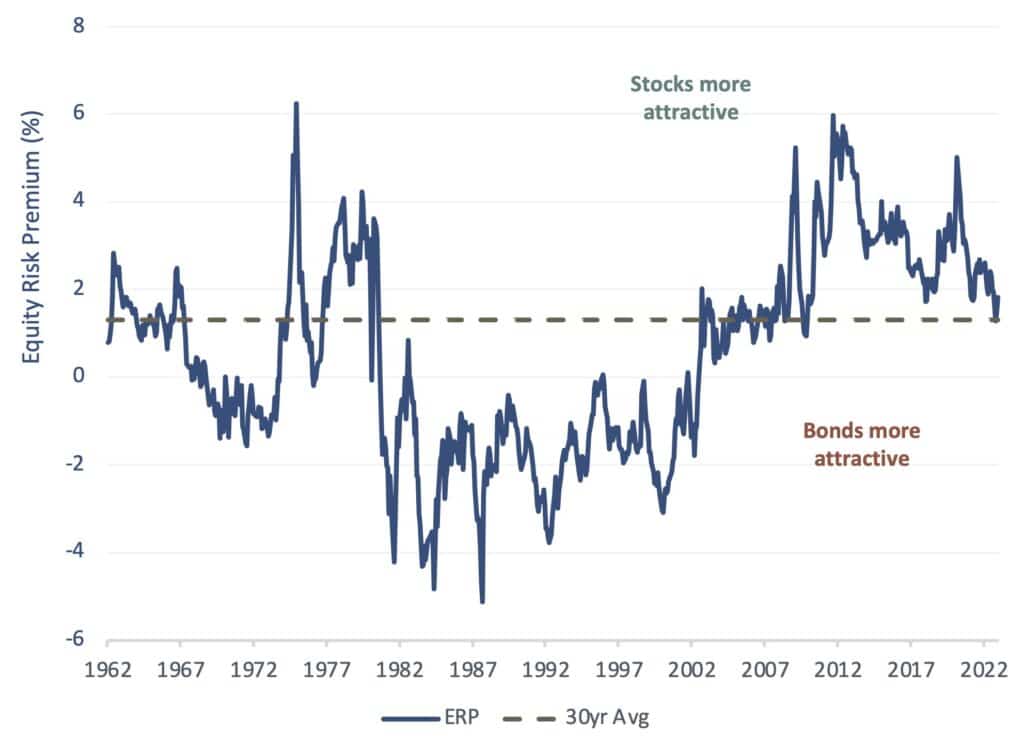
So this is a chart of real rates. Real rates, meaning the stated yield of a bond, less the expected level of inflation. So what you’re really earning above and beyond inflation. Real rates are at levels we haven’t seen since 2009. So that bond investor who’s really wanting to be income oriented has the ability to actually earn something for the first time in nearly a decade.
That’s one reason why we think the bond market is, with all the fed rate hikes, is more attractive now than has been in in quite some time. Another way we look at the bond market is relative to stocks. One common gauge that we use is the equity risk premium. This is a way to boil down the data to get some type of comparison between stocks and bonds. At the end of the day equity risk premium is just the earnings yield, so the earnings divided by the price of the stock.
And this compares the equity risk premium or the earnings yield on the s and p 500 to that on the US 10 year treasury yield. A way to think about this number, to distill it down pretty simply, if you have a stock that’s a hundred dollars and it earns $5 a share, the earnings yields 5%. If you have a bond that has a power value of a hundred dollars and it pays you a $5 coupon annually, the yield is 5%.
So what we see right here over the past, the better part of the last decade, stocks have been more attractive than bonds. The earnings yields have been higher on the equity side than the yields have been on the bond side. And we’re finally coming to a point due to interest rate increases that the sharp and rapid rise in interest rates that bonds and stocks are pretty close to parody. Meaning that you’re indifferent based on historical averages to own one versus the other. This gets to be a point where it’s pretty attractive to hold that more diversified portfolio, to allocate more to bonds at this point. And, we’ll see what happens as the year goes on whether or not earnings come down and bonds in fact become more attractive.
But right now it’s pretty even. So Daniel, kind of given that high level overview fixed income appears attractive, and may be getting more attractive. Should we, do we just blindly allocate to the asset class or is there specific areas of the fixed income market that we’re looking to avoid?
[00:05:39] Daniel Dusina: Well, I think first and foremost, it’s very easy to just blindly allocate to fixed income today, considering where we are today versus where we were just a year ago.
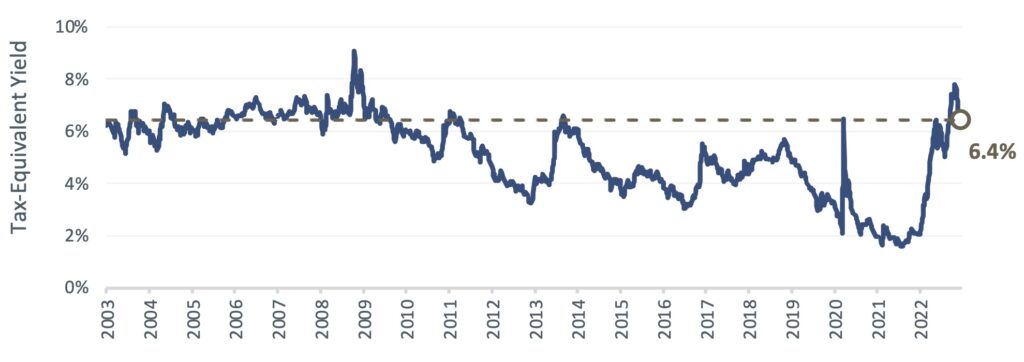
So just zooming out, taking a step back where we were at the start of 2022 was in an environment where investors that were looking for income were better suited by going to equities than the majority of the fixed income market. You can see those brown bars in the, the slide that I’m sharing in the, in the bottom half of the screen, that dividend paying stocks were just distributing more income than the vast majority of bonds. That’s been flipped on its head due to actions taken by the Federal Reserve to combat inflation: broadly hiking interest rates in an aggressive manner. And what that has equated to is rising yields across the fixed income market. Having said that, given the economic pressure that we do see starting to mount and some of the uncertainty on that front, we’re a little bit more cautious on high yield bonds.
High yield bonds are a little bit further along the risk spectrum on the bond side of the equation, and generally speaking, in times of economic stress, we see the yields that they have to pay out in order to gain access to additional capital increasing significantly. You can think of these higher yield bonds that are issued by generally lower quality, less well capitalized businesses, as very good return instruments when the market’s running hot, but generally can be a little bit more challenged when times are tough in markets. So high yield bonds, when they’re issued, they have to pay a spread over and above a risk-free rate to compensate those investors for the higher level of risk involved.

And when we look at those spreads today versus where they have been historically, when high yield bonds are priced on average as they are today, which is at a 13% discount of par, investors are plain and simple just not being fairly compensated for the level of risk involved at a 13% discount to par on average per high yield bonds.
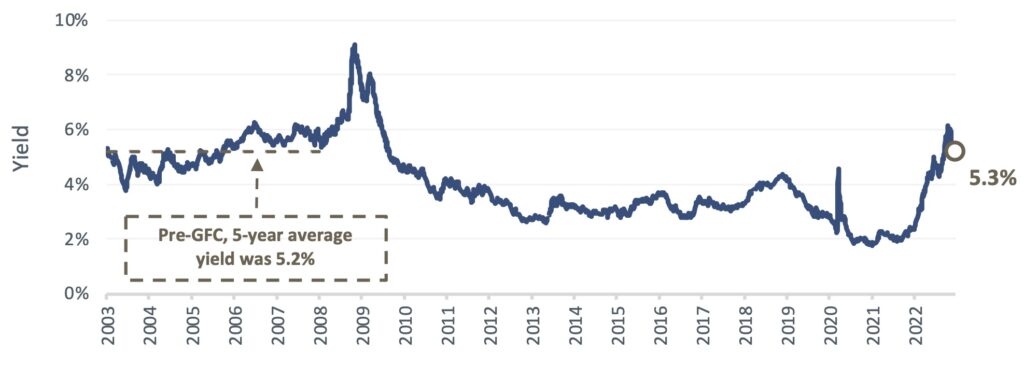
Investors have usually received about an 8% spread over the 10 year treasury. That spread today is only at four and a half percent. We think there is further room for these spreads to increase throughout the year and think we will ultimately get a better entry point later in the year, especially considering some of the economic pressures that we’ve mentioned.
This will shake out some of the lower quality issuers in the market. And so we’re just a little bit cautious on the space today. We do think that allocating to a minimal portion of the market is good, but we’re not as optimistic on this space given the juncture we’re at. Now in terms of what we do find attractive: Dan, do you think you could walk through some of the portions of fixed income that are ripe for investment today?
[00:08:38] Dan Seder: You bet, you bet. Thanks Daniel. As you highlighted, there are times when it makes sense to take risk in the bond market and now isn’t one of those times. Instead, investors should look at safer segments of the bond market, and we would think that would include investment grade corporates and municipal bonds.
So what I want to do first is break down both of those categories. To begin with, what’s the difference between high quality and high yield? We think of high quality bonds as Blue Chip debt. That’s a common term for us here at Blue Chip Partners because it’s the foundation of our stock strategy.
High quality bonds are Blue Chip debt, and let’s start with investment grade. These are bonds issued by high quality companies with a relatively low probability of default. And just to be clear, we’re not calling for a slew of defaults. However, investors will gravitate towards safer bonds in economic uncertainty, which could be the case in 2023.
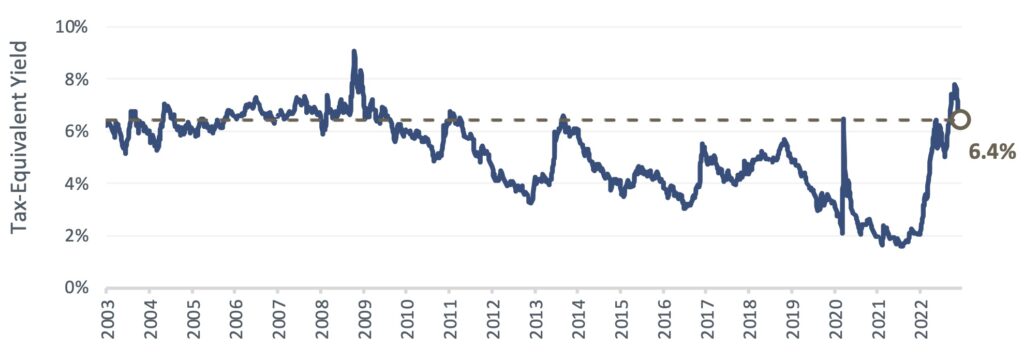
So it’s top of mind for us. And as you can see from the chart, investment grade corporate bonds were yielding 5.3% at the end of December. Yields in this space haven’t been this high in a long time. And as you can see, today’s yield is consistent with the five-year average yield that the investment grade corporate space had leading up to the global financial crisis.
Next you have municipals. Unlike a corporation that needs willing buyers to generate revenue, municipal bonds are issued by municipalities that collect tax revenues. So that’s a really powerful tool for staying solvent. As y’all know, we have to bear taxes. There’s really no way around that.
So for municipalities, the ability to pay debt wasn’t an issue or repaid debt wasn’t an issue in past recessions, which is encouraging if we experience that economic softness that I referred to earlier. And finally, the default rate across this space is the minimus, and credit ratings, which are a way of measuring the issuer’s ability to repay their debt have continually increased.
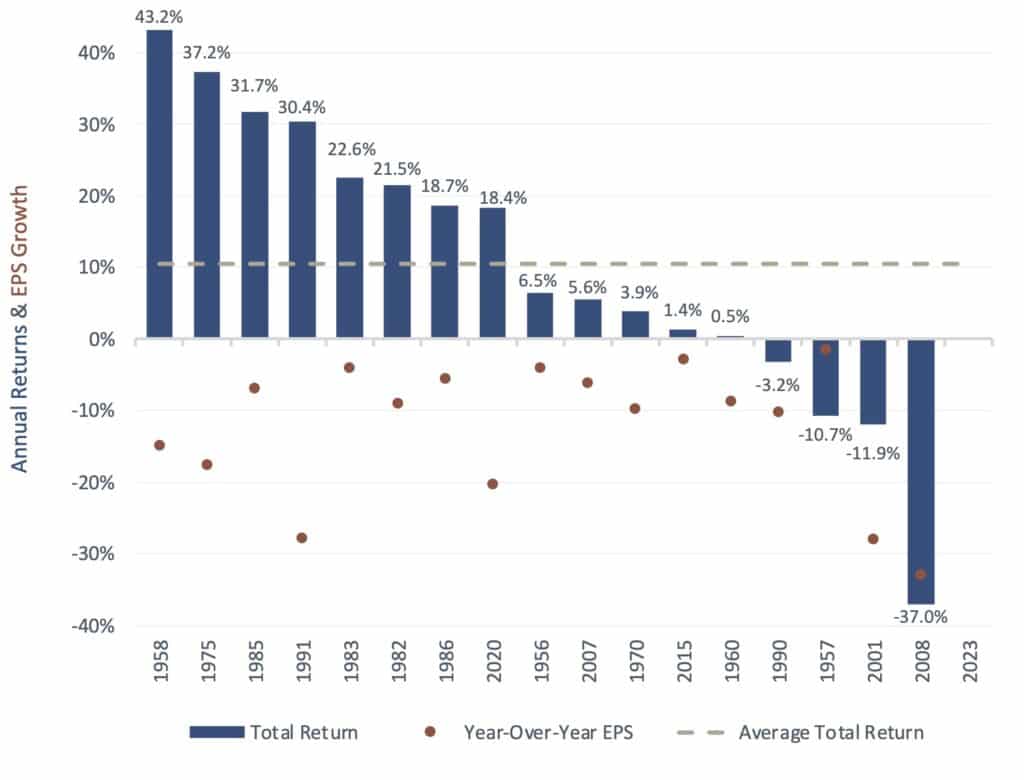
So as you can see from this chart, muni bond tax equivalent yields are up to 6.4% as of the end of December. We view this rate as extraordinarily attractive and a level rarely seen over the last 15 years. So the bottom line is this, investors can get most of the bond juice out of their bond squeeze by sticking with higher quality.
[00:11:14] Daniel Dusina: So, Dan, understanding all this quality and fixed income, I think that makes a lot of sense at this juncture. But let’s switch gears and take a step back. Inflation was one of the primary headwinds to markets in 2022. As we think about the equity side of the equation, do we have any context for the current state of inflation and what it could mean for the domestic equity market in 2023?
[00:11:38] Dan Seder: Yeah, you bet. This this is a great topic and I’m excited to talk about it. Let’s face it, inflation took off after Covid. The culprits were supply chain, fiscal policy, and monetary stimulus. So when we studied higher inflationary environments, like when the consumer price index or CPI was above 5%, there were some really interesting takeaways.
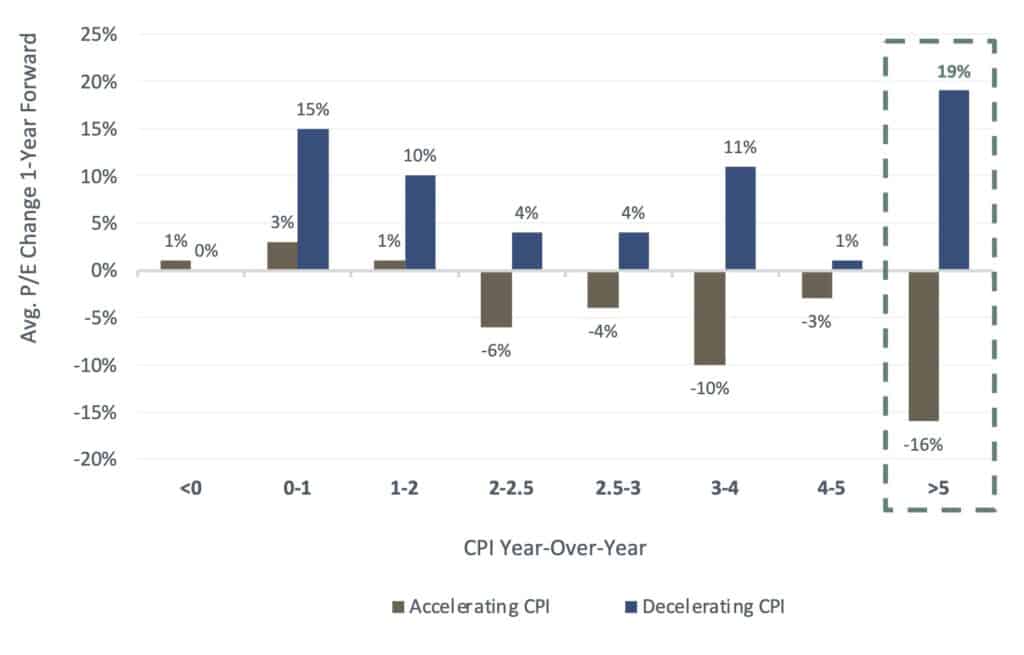
What we found was the level of inflation was less important than that of the trajectory of where rates were headed, and here’s how it plays out. So take a look at the dotted box on the right side of this chart. When inflation is high, and remember we called that core CPI north of 5%, and accelerating to the upside, stocks get punished and that’s represented in that downward pointing brown box indicating a 16% hit to prices relative to earnings in that environment.
On the other hand, in the same high inflationary environment, again, I’ll state it core CPI, north of 5%, but decelerating this time to lower levels, stocks flourished. You’ll see this in the upward pointing blue box indicating a 19% expansion of prices relative to earnings in that environment.
To us, this is a clear representation that the stock market is a discounting mechanism for the future. Investors are less concerned about what’s actually happened and eager to invest according to what’s coming down the road. The bottom line is this: rapid deceleration in inflation should be a net positive for stocks.
The question remains, how will earnings fair in 2023? So, Matt, I’m gonna shift this over to you. There’s a lot of talk about corporations earning less and the feds trying to slow down the economy. Should investors be worried about corporate earnings?
[00:13:33] Matt Mondoux: Yeah, a great question, Dan. Thanks. So, corporate earnings there’s definitely the potential for pressure.
I believe it’s from a very high level, corporate earnings have been extraordinarily strong the past couple years. So, pressure is coming from elevated levels. But that does not mean that we should just avoid equities. There’s actually some strong data here that shows what are s and p annual returns when earnings growth is actually negative.
So there’s been 17 such occurrences over the past, or back to 1950, 1955. In 13 of those 17 years, the markets are, were positive with the average return being north of 10%. So Dan, I think that ties back to what you just said. The stock market is an ultimate discounting mechanism. They’re always looking forward, and the next year’s earnings are only one piece of that overall equity valuation in which investors choose to purchase or choose to sell stocks upon.
We do believe removal of some headwinds, increasing inflation, Dan, to your last slide and aggressive interest rates from the Fed can actually do a lot to stabilize financial markets and really help investors understand the growth profile for a lot of these businesses going forward. There is some pain. I mean, you know, technology for example, you could argue that sector is somewhat contracting.
More layoffs are coming out and out. So, there’s pockets of the market, certain sectors that could go into some type of contractionary earnings growth more than others. But like I said, this chart shows that just because we’re contracting doesn’t mean negative performance coincides. In fact, this suggests the opposite.
So, Daniel, I think we have time for maybe one more. I’ll allow one back to you. Daniel, final thoughts on equities in 23?
[00:15:24] Daniel Dusina: Yeah, I mean, I think, you know, again, taking a step back, looking at a high level I think is important in markets like we are going through right now. One of the items that we watched very closely is an aggregate subset of leading economic indicators. These economic indicators, as their name describes, are expected to be, you know, the first shoe to drop, should things start to deteriorate from an economic perspective domestically. And so we have seen rapid deterioration in this aggregate basket of leading economic indicators. I don’t think it’s any surprise because number one, we were coming off of a period of massive expansion off of the back of the pandemic, so year over year indicators from a leading perspective were incredibly strong.
Comparisons on a year over year basis last year were incredibly difficult. The exact opposite of that is true this year. Where we have very low comparisons to look at on a year over year basis, which to us indicates that we will see some semblance of an inflection point in these leading economic indicators in the middle of this year.
The reason I bring all of this up is because the best leading economic indicator is actually the stock market, the s and p 500. You can see it on this chart, which I’ll describe in a moment, but you can see that the s and p 500 actually tends to bottom before leading economic indicators and ultimately in flex upward, generally before leading economic indicators.
So you can see this happening in 2015, in 2012, in 2005, 1995. The leading economic indicators index is shown in the blue bars or the blue line at the bottom of the screen, and the s and p 500’s trailing 12 month return is shown in the brown bars. So it’s not like we’re trying to call a bottom in the stock market or anything of the sort.
All we’re trying to say is that I would very closely watch for potential inflection in these leading economic indicators in the middle of this year, but I wouldn’t be waiting on the sidelines in the equity markets in anticipation for that to happen because history would tell you that that’s a losing proposition.
So with that in mind we’ve asked each other some questions and I would still encourage anyone participating online here to throw in any questions you have. We’ve had one roll in so far, and I’ll take the first stab at addressing it while you know, some others have a chance to throw some questions.
But the question is, given what you have said, how should I view duration or a duration ladder for bonds? Duration, for those of you who are unfamiliar, duration refers to the interest rate sensitivity of a fixed income instrument. So how sensitive is the price of a bond to a change in interest rates?
Higher duration means more sensitivity. Lower duration means lower price sensitivity. I’ll start by saying what we did as a firm last year going into 2022. We reduced duration in anticipation of the Federal Reserve hiking rates. About a quarter of the way through the year, the Federal Reserve came out incredibly aggressively, and we reduced duration further, which proved a prudent exercise.
And we were waiting for the timing to be right, to start to leg back into duration. We started that exercise in the back end of the summer of last year, and we furthered that exercise at the end of the year. And so that’s a long-winded way of saying, I think that you can finally start to dip your toe in the water of duration because of the fact that much of the aggressive monetary policy from the Federal Reserve has started to be priced in.
In fact, right now the markets are pricing in just a normal, believe it or not, 25 basis point rate hike for the February meeting, which you know, is a little bit unfamiliar to us now that we’ve just seen four straight rate hikes of 75 basis points. But I think the fact of the matter is, I think that now is the time to start taking advantage of some of the yields that are available, in some of the more duration-oriented instruments. Keep in mind, the municipal bond space that Dan walked through earlier is one of the only spaces in fixed income that actually does not have an inverted yield curve, aka longer duration instruments and municipals pay you more than shorter duration instruments.
In terms of a duration ladder for bonds, I think that diversification in the fixed income space is always a prudent exercise. Whether it’s obtained through a duration ladder or a diversified basket of exposures to different subsets of a fixed income market. I think it’s a winning proposition, and I think, like I said, you’re finally getting paid for it no matter how you slice it.
As long as you’re diversified, I think you can construct a very quality portfolio that can generate a strong outcome for years to come. Dan, Matt, anything I missed on that front?
[00:20:32] Dan Seder: I don’t think so. I just think, you know, I picked up on one comment you said about right now the normal hike of 25 basis points, which is anticipated by the markets for the Fed’s next move. You know, this doesn’t necessarily relate back to duration, but I think the Fed is has been towing a pretty hard line about being hawkish.
It’ll be really interesting to see how that plays out on February 1st when the Fed meets again, because, you know, the Fed just can’t go out there and have any semblance of a dovish tone. Until they actually pause, they have to hold that hard line, that they’re gonna take the terminal rate up into the fives. Otherwise they’re gonna just unwind everything that they’ve done to get us to this point. The markets would rally, and the Fed doesn’t wanna pause interest rate hikes into a big expansion in stocks, so it’ll be really interesting to see whether that 25 basis point hike plays out February 1st. My gut tells me that might not be the case, but we shall see.
[00:21:37] Daniel Dusina: Without a doubt. I mean, the, the primary headwinds to both equity and fixed income markets last year were inflation and the subsequent action from the Federal Reserve. So those remain the key talking points and the key items to watch this year.
We had a second question roll in. It relates to inflation; good segue. It’s: do you think that declining inflation could actually be a concern for various sectors such as consumer staples, which were passing on price raises to boost sales all while volumes were actually declining? Dan, do you wanna take the first shot at this or should I?
[00:22:11] Dan Seder: Go ahead. I’m trying to open up the questions. I’m having tech technical difficulty on my end. You go ahead and give it a start and then I’ll add.
[00:22:18] Daniel Dusina: Yeah. Well, I think this is a fantastic question because this is something that we talk about all the time. So when you look at a sector like consumer staples, part of the reason that it can do very well in certain recessionary scenarios or in a high inflation scenario, is because of the nature of the products they’re selling. These are staples. These are not the type of goods that consumers cut out of their lives just because times are getting tougher. Now, I would say that what we saw last year was a great ability from the sector overall and many companies within the sector to be able to not just eat the inflation that was being presented to them, but take that inflation and pass it down the supply chain to the end consumers.
This is at the end of the day, what you look for in a quality company. You find a lot of them, consumer staples because of the imperative nature of the products they’re selling. Now, inflation, allowing them to pass on higher prices and ultimately being the fuel for their revenue growth last year, you know, that’s all well and good. What happens when the rug is pulled out from underneath them and they don’t have the ability to continue to hike prices?
I think I’ve talked about Pepsi’s third quarter of 2022 on these webinars in the past. I mean, they grew organically on the revenue front by 17%. That was all due to higher prices. Volumes actually declined. So what we see going into this next, going into 2023, is that we’re a little bit more cautious on some of these parts of the market that simply received a boost because they were able to pass on higher prices. Given that we’ve seen inflation on a year over year basis top and has come down and will continue to come down, in our view, that’s less of a tailwind for those firms that are simply growing on higher net price realization.
[00:24:18] Dan Seder: Yeah, I think that’s well said. I guess I’ll take a different twist on the answer and it’s not really answering the question, but a spin on the concept. Even though the tailwind isn’t there necessarily for staples, which is a sector we’re talking a lot about right now because of valuations, right, valuations are relatively high given where staple stocks have gone and the price levels that they’ve maintained. The economic uncertainty that’s potentially ahead of us in the first half could lead to investors flowing to staples as a safe haven. So there’s this really big debate and this tug of war between, you know, the potential headwind that you could face after what Daniel just described, or I guess the tailwind has stopped in staples with regards to inflation.
Now there might be a tailwind for staples going into an uncertain economic environment because it’s a safe haven for investors that are looking for stocks that we all need and use regardless of the economic environment. So the classic definition of a staple is, something that isn’t sensitive to the, you know, the ups and the downs in the economy. Could be toothpaste, could be deodorant or laundry detergent. But the things that you’re gonna use regardless, and they may prove to be resilient if the economic environment deteriorates. So I do think that’s another interesting development that we’re gonna watch closely, continue to discuss internally and see, you know, what ends up panning out.
And frankly, I mean, we look at a lot of data. Anyone that has the crystal ball or thinks that they have the crystal ball to know that answer is downright, you know, full of it. So this is a developing environment, one that we have to see what the Fed does first and how the economy reacts second to really, you know, determine the best moves to be making in both the stock and the bond portfolio.
[00:26:18] Matt Mondoux: And, I’ll just jump into, I mean, one form of declining inflation that should help all sectors is wage inflation. So to the extent we start to see less year over year wage growth for employers you know for their own margins and business outlook that can actually be a benefit to them.
[00:26:37] Daniel Dusina: Without a doubt. I mean, all great points. Inflation’s going to continue to be top of mind, especially considering that’s action that Dan mentioned. I didn’t see any other questions flow in, and we’re just about at four 30, so I think we are all set to wrap up here. Thanks again for joining everybody. If you didn’t ask a question and one comes to you later, please do not hesitate to reach out to us.
Our email addresses are shown on the screen if you do not already have them. And finally, I will just reiterate if you do want the content from us such as our quarterly outlooks on a more timely basis, please do follow and like us on LinkedIn and check out our blog. I’ve got QR codes for both of those locations below on the slides that are being shared.
But again, if you have trouble accessing, do not hesitate to reach out. Thanks again for joining, and until next time, I’m Daniel Dusina, joined by Dan Seder and Matt Mondoux. We hope you enjoyed.
[00:27:36] Dan Seder: Thank you.
[00:27:38] Matt Mondoux: Thank you.
Disclaimer:
Expressions of opinion are as of January 18, 2023 and are subject to change without notice. Any information provided is not a complete summary or statement of all available data necessary for making an investment decision and does not constitute a recommendation to buy, hold, or sell any security. There are limitations associated with the use of any method of securities analysis. The information has been obtained from sources considered to be reliable, but we do not guarantee that the foregoing material is accurate or complete. Every investor’s situation is unique, and you should consider your investment goals, risk tolerance, and time horizon before making any investment. Prior to making an investment decision, please consult with your financial advisor about your individual situation. Past performance does not guarantee future results. Investing involves risk, and you may incur a profit or loss regardless of strategy selected. There is no guarantee that any statements, opinions, or forecasts provided herein will prove to be correct. Dividends are not guaranteed and must be approved by the company Board of Directors. Indices are included for informational purposes only; investors cannot invest directly in any index.